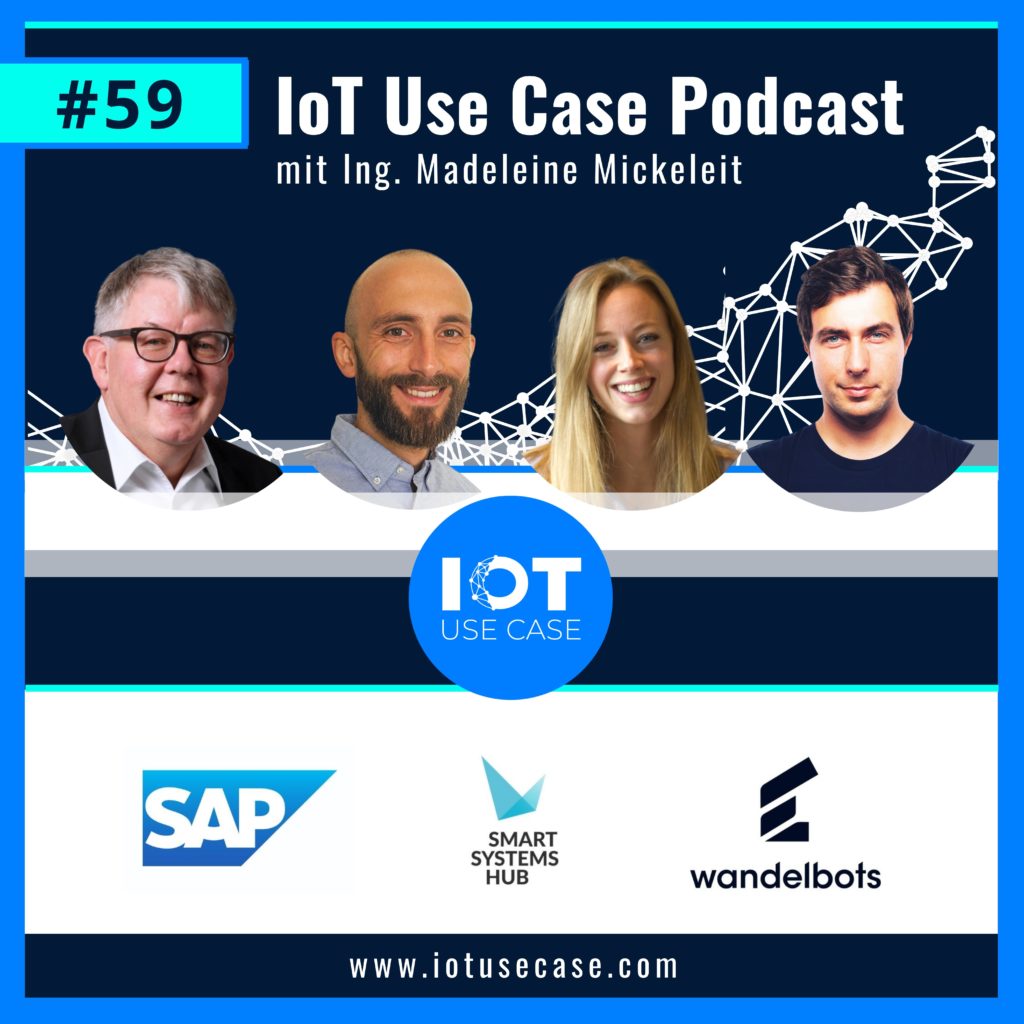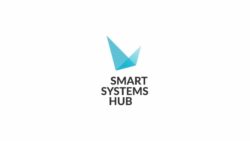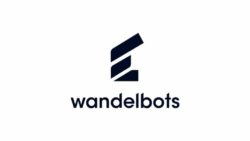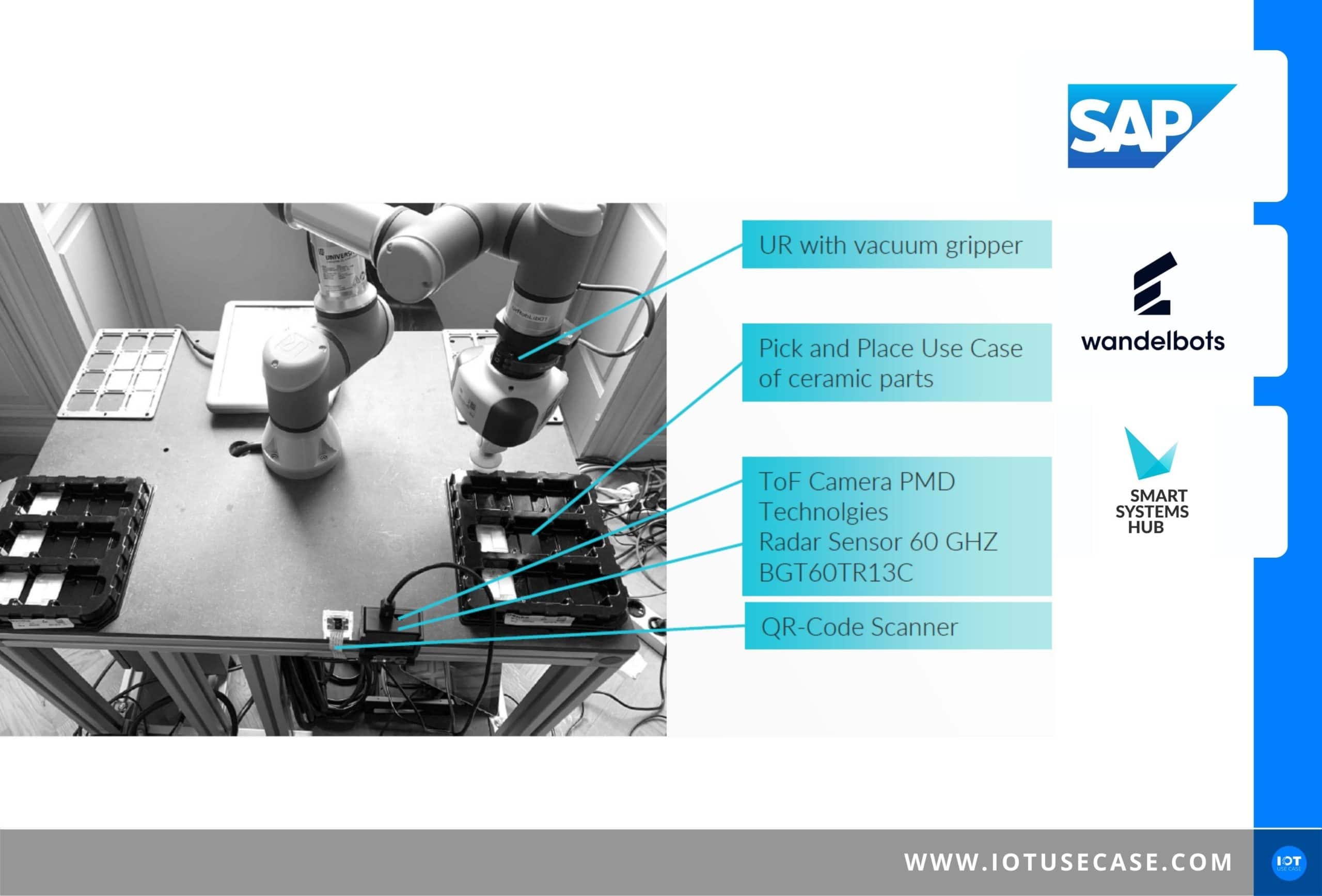In this podcast episode, Madeleine Mickeleit talks to one of the largest IoT hubs in Europe, with over 450 partners in IoT and AI and working directly on behalf of the German Federal Ministry for Economic Affairs and Energy – Smart Systems Hub. Hans Klingstedt, project manager for co-innovation projects, is a representative guest here.
Joining us on the podcast are two partners in the Digital Product Factory innovation project:
- Georg Püschel (Co-founder, Wandelbots)
- Mathias Kaldenhoff (Partner Sustainability & Innovation Management, SAP)
Podcast episode summary
What do the companies that present their project in this episode do? Smart Systems Hub helps SMEs integrate IoT technologies with a focus on process optimization in the production environment. Wandelbots is all about intuitive and simplified access to robots with the help of software. The start-up is at the forefront of “no-code” for robots – programming robots without having to write any program code. With SAP, they have the unique USP of making this data usable in the ERP as well.
The featured project of this podcast is part of the “Digital Product Factory” format of the Smart Systems Hub. Here, project approaches are discussed together with key partners in an initiation and initialization phase – a very large network of knowledge and know-how.
This episode revolves around a testbed for increasing the efficiency of robots and developing an asset-as-a-service business model based on a software solution. Despite a high degree of automation, robots often still have potential – especially in their interaction with humans. How can a robot learn to understand which work step a human wants to do next? SAP Germany and semiconductor manufacturer Infineon jointly addressed this challenge at Smart Systems Hub.
What the solution and the result looks like and what (transferable) added values there are can be heard in this podcast episode.
Podcast interview
Hans, would you like to introduce yourself briefly; briefly about yourself and your company, what exactly do you do?
Hans
My name is Hans Klingstedt. I have been with Smart Systems Hub for a year and a half. My focus is on IoT project and innovation management, where we bring together different companies with their expertise and create innovations together in a collaborative effort. I am an industrial engineer, then I was responsible for software implementation projects for a longer time at a larger automotive supplier, also for in-house consulting. And now I’m very happy to be on the road in IoT.
For those who are not yet familiar with the Smart Systems Hub: As you said, on behalf of the BMWi, we support small and medium-sized enterprises in the integration of IoT technologies, with a focus here on process optimization in the production environment, where we rely very heavily on the collaboration of startups, industry and SMEs and where we create a space for innovation, provide development teams to work together on challenges and use cases.
Georg, could you also briefly introduce yourself and what exactly you do at Wandelbots?
George
My name is Georg Püschel. I am a co-founder of Wandelbots. Wandelbots is about intuitive access to robots – so programming, operation, the whole setup of robot cells. How to make it easier through software. We just founded the company four years ago, so we are a classic venture capital startup, in Dresden. My job changes very often. At the moment, I’m mainly concerned with all cloud topics, i.e. how to bring a robot, a machine together with the cloud infrastructures of hyperscalers, for example. Wandelbots’ main product is actually a tracking device, with an app to go with it. The device is called TracePen, and with the app you can automatically translate the data you collect with the TracePen into robot movements in a robot cell – that’s teaching. Our customers are all those who already have robots now and want to make production more flexible – like a pen, for example, which goes much faster. Or someone who doesn’t even have access to robots yet. For the physical robot cell, we can rely on our partner network, which consists of system integrators. As I said, I’m now going one more way into the cloud – that’s my role as an expert at Wandelbots.
You’ve really picked a really exciting area and also set the goal of radically simplifying robot programming without having to write any program code at all. I find it insanely fitting for what we do in the network as well. And this TracePen that you mentioned is a teaching function of Wandelbots that enables virtually anyone to program a robot – which is of course also exciting for small and medium-sized customers out there. To conclude the round of introductions first, Mathias, would you like to introduce yourself briefly as well? SAP is of course known as a large software company, but I would be happy to learn a bit more about you and also your area of expertise.
Mathias
I, Mathias Kaldenhoff, have been with SAP since 2013 and have already been working in the area of database and data management for about 25 years, as well as in the area of middleware. I’m in Partner Innovation Management in the CTO Office in Germany, and I support organizations, such as partners, or customers who are to become partners, or organizations that have contact with SAP for the first time ever, in their innovative solutions in four sub-areas. The first area is store floor management, which is always where production takes place. Of course, this also includes all machines, robots and systems that are at all capable of production, as an asset-as-a-service model. Today very important, when I talk about the entire assets, is a sub-area, energy efficiency data management, which I then actually also associate with the term sustainability and climate solution in various projects.
Together with SAP Germany and Infineon, you are now the so-called challenge donor. Hans, this project that you are presenting today is a challenge that runs under the Digital Product Factory framework. Can you pick us up here on the background and give some context to this project?
Hans
Smart Systems Hub has different formats, that’s what we call it. One of these is the aforementioned Digital Product Factory, where we discuss project approaches together with our key partners and their partners – a very large network – in an initiation and initialization phase. In this phase, in the run-up to the project, we found a very interesting overlap with SAP and Infineon in the field of robotics.
Georg, we’ve just heard from Mathias, it’s about new business models. You explained that it’s about intuitive access to robots, too, keyword robot teaching, also about cloud topics. Can you pick us up what moves your market and customers from this industry, and especially in this context of digitalization? What do you see for movements
George
In industry, especially in the production industry, where industrial robots are used – for example, the automotive industry, the silicon industry, but also many others, these are just the two most highly automated – robots must be digitized. After all, the trend towards Industry 4.0 can only be achieved – and with it the reduction of batch sizes and the flexibilization of such machines – if the machines are made more intelligent. This requires a link with software. Software is the source of all machine intelligence. This cannot be solved with such a simple-integrated system. That’s why digitization and Industry 4.0 for us is also the connection to cloud and adjacent systems that work there. That’s what we want to achieve. All the trends of IIoT, artificial intelligence, virtual reality, augmented reality – they can help in the production environment to make work more flexible, easier and, in the end, what counts for all automation companies, to increase productivity.
Yes, working more flexibly and increasing productivity are the keywords here. Hans, what are you observing in the market in your projects? What was perhaps a bit of the starting point for working with SAP and Wandelbots?
Hans
What we are observing is that digitization and also the application of IoT is a fundamental prerequisite for the competitiveness of smaller and medium-sized companies in particular. We see that the complexity in these IoT projects – this has already been mentioned in several of your podcasts – is often high and that the system solution in particular requires cooperation in order to make different expertise and technologies accessible. This is also the context in which we have been working on this project. I have just mentioned that we have combined the two interesting challenges of SAP and Infineon in a nice project. They were the challenge givers, so to speak, the challenge owners for this Digital Product Factory. We were then able to work here together with the Wandelbots company, Georg Püschel, with the software for robotics – Georg called it “the source” very nicely – to bring intelligence into the robot.
That was the perfect segue to SAP. Mathias, what was important to you at the start of the project? As a challenge giver, what are the issues that have moved you?
Mathias
We need to bridge the gap between a purely manufacturing system and the data managed there with actual order data, with performance data and with predictive data. This means that if at some point we want to be able, for example, to simulate a machine via data – that is, to represent a digital twin in order to then say what and how it will produce in the next time units, in the short term, how much electricity does it need for this and where do I get it? -, then we are no longer just talking about democratizing access. For me, digitization is always a democratization issue; it always has been. The Internet has given more people access to information. And digitizing a machine, a robot, a plant gives more people access to the machine and what it does. It also lowers the barrier to entry. – Now, if I can use that data to make my order management, my forecasting, and my whole production line run smarter, smoother, and better, then that’s of high interest to any kind of production, any kind of order management, and any kind of forecasting. We have already demonstrated this in other projects: Together with another partner who helped a great deal with the change – objective partner is the name – we have also used the asset-as-a-service theme to actually enable people to participate who would otherwise not be able to participate in such processes because they cannot manage the complexity, for example due to a lack of manpower – who has energy managers in the SME sector?
Georg, what exactly are you doing on the Wandelbots side of this challenge? Could you situate the project a little bit in terms of content and give us an overview of these individual fields of action that you have here?
George
You first have to take a closer look at what the various dimensions or aspects of the challenge were. The overriding issue was freedom from interruption. But of course, from a robotics point of view, we did three different things: one is an intelligent robot with some kind of camera and an AI system that directly manipulated decisions of the robot in its actual task. Then predictive maintenance via SAP systems. And at the end, the asset-as-a-service management, i.e. the usage-based commissioning and billing of the robot. You can imagine that for the task that went into robotics – that is, with the AI camera – we typically trained the AI model directly on site. So we trained the camera, which needs latency-free access to the robot, using an edge system – that is, a system that is very close to the machine. We then linked the trained model to the robot, via a local system, so that decisions can be made directly in the cell. This data ingestion was a task that we invested a lot of time in here in the project. The other two components are mainly about transporting the data coming from the machine into the cloud infrastructure. That was my main task. There has to be someone there who is a cloud engineer and knows about the different resources and services that exist there. Because the link between our infrastructure, so the automation, the part that understands the automation, and the systems that work on the other side – so for example SAP Analytics or the partner that did asset management, namely objective partner – these systems have to be integrated. But then again, that is a classic integration task in the software area. Much emphasis is also placed on how to transport the data. That’s the challenge there.
That is, you first have the robot itself, so to speak, which is made intelligent. Quasi with the upstream and downstream process. So the question, how can a robot understand what a human might also want to do next? Everything around this human-robot interaction plus the software and intelligence is then accordingly the part of Wandelbots. And then we have the second area, so to speak, where the challenge is to get the data from other systems In the final step, it will be possible to use this data to offer the robot as a new business model – in other words, to develop an asset-as-a-service business model based on the software solution. Perhaps for those who have never heard of the issues or the new business model in this direction: Asset-as-a-Service is a business model where you no longer carry the robot on your balance sheet as a longer-term asset, but really only pay as you use it. This means that I no longer buy the robot, but pay according to use, and this is based on data – i.e. the use of the robot is controlled, monitored and billed accordingly. This offers several advantages. Listen to episode 4 with Josef Brunner – his explanations are still up to date and very charming. And in episode 25, Jonas Schaub from the company elunic explains it again. Mathias, to go deeper into the practice: What are the challenges here and what data are you interested in? You mentioned middleware earlier. Implementing robots with the new business model – how does that even work?
Mathias
After all, our challenge was that we actually have to interpret the sensory data plus the environmental data coming out of the robot. That means we used a middleware that comes from the Fraunhofer Institute, it’s BaSys, BaSyx – it’s called the management shell and it’s an Industry 4.0, open-source product that we can then actually use to map the digital twin. What data was important for us? To take a first step. Let’s say we have a robot that is as safe as possible and can act as a cobot in a safe environment. Then we need to know, what actually is a skill? So what is a work order and by what movement of the robot does it form and when is it finished? In the past, one would have said a start and a stop sentence. Then, of course, we need data, what should he actually do? And then we need data, in what performance and speed, in what change can he do that? And then not only because of the interaction with a human, for example, moving in the environment monitoring. But to actually measure the performance data of a robot, i.e. sensory data, in order to then – as we very often do – aim for a line change, for example. That is the first thing. The second is that we need data – I just talked about these skills. After all, at some point, either internally or externally as a rental model, we have to cancel the transaction that the robot makes – it is, after all, a fixed asset. That always has something to do with which order he gets, too. And if we manage – and I think this was one of the challenges that we solved exquisitely and well – to link the order with a skill of the robot that was trained beforehand, and then also to know when the order was triggered and when it was completed, then we can measure everything that the robot does and that is relevant for order management or the store floor system through the sensor system and also count it and, for all I care, weigh it. We can then do what is important for the order. Then we have the link between individual skills and individual order orders. This means that we can theoretically link a single order to a single skill via the visualization of a QR code, for example. This means that we can also give the robot special orders and are thus segment-of-one capable. This is all such relevant data. I would say everything that happens in the transaction. And how it happens and in what performance it happens. This is relevant for the order. Everything that happens in the area of speed, current consumption is relevant for the performance of the order. And if you put these two things together and read them out via the asset, so to speak, or actually link them with analytics and AI, then you are also very quickly in a position to do so-called forecasting – on power, performance, line. To then say, on which of the robots involved do I execute this job now?
I’ll try to put that into my own words. This means that in the future, the robot will recognize the movements of people in the vicinity, for example, and then decide via AI whether the person should come closer to it, so to speak, or not – and depending on this, the robot will change its behavior. Keyword, interpretation of data or AI, which we have just mentioned. And now, with the so-called middleware, i.e. the management shell from the Fraunhofer Institute, BaSyx, I have the possibility to record these important addressed data in the robot via a uniform interface, in order to then visualize these processes and to see, for example, a line change – keyword Digital Twin and data, exactly as you have just explained. And then on top of that, I can use that data appropriately to digitize the new business model for the robot and handle the forecast planning and everything that I do in SAP. Super Exciting. Of course, these are also very complex approaches in this project. Various use case technologies, also expertises, which also have to be sorted here. Hans, that’s where I think you come in quite well from this innovation area. How do you go about it? How do you go about such a process and how exactly do you get involved here
Hans
It starts with tailoring the project by sorting out the necessary technologies after discussions with the respective challenge owners and then also searching for and integrating expertise in our partner network accordingly. That was just as much the case here with Wandelbots. Mathias also spoke with objective partner, for example, and we were then able to work on this joint case. This is then done in the classic way via a project profile, where we organize these technologies and then also list which resources we need. So what skills, which we then also filled up internationally with talent. Where then saw accordingly, what does it take for this system solution? Where do we need such expertise to build this infrastructure? This is how we then proceed piece by piece in the preparation phase to map this project team. You mentioned complexity earlier. In fact, that was a challenge at the beginning, where we then also formed sub-segments, processing blocks, in order to be able to control the 17 project members well overall, so that in the end we can map a minimum time approach with maximum co-determination for Mathias, of course, but also for Infineon as the challenge owner – but at the same time the project teams can work well and efficiently. That is also a great added value that we provide with that we make sure that a good coordination of the teams is mapped by us.
If I now imagine that in this complex project you also come together with all the project members to tackle the individual areas – be it the billing topic or the data transport – how do you have to imagine, how do you bring the knowledge, the competencies into the digital at all? After all, I have to make sure that the topics end up in the cloud, even in a structured way.
Hans
Let’s leave aside the data acquisition meetings at Georg’s, where we met regularly to train the AI model – to collect enough data to get the model robust. Apart from that, we actually mapped all the appointments digitally in a virtual environment, where we used different tools to communicate. We formed virtual rooms where we met at processing times, processing blocks and divided them up well and worked with different tools. It starts with sharing the screen, through communication channels like Slack, to Bitbucket to share codes, to collaborative coding in a work environment. A real mix in the virtual environment, where we settle in very quickly at the beginning of the project.
Georg, what exactly does your solution module look like here? You are now a project partner in the whole conglomerate. How does your solution work at this point?
George
You can imagine that Wandelbots always provides an edge device for industrial robots anyway, which then works together with the robot controller, i.e. the computer that comes with the machine. Inside this industrial PC is our software platform, and that’s what we use to solve the various challenges in the project. You can think of it as this IPC is basically an intermediary between the on-premises world, which is the production line and OT, and the cloud world. Basically, services are implemented and software that take care of the mediation between the machine, the data transport units that reside at a hypervisor, for example, Microsoft Azure. And in the end, additional services that are transported from there in turn into the target system, for example SAP. In other words, what we did at Wandelbots is almost just software plus a bit of programming a robot, in other words, solving the classic automation task. And the interaction of everything together then solves the challenge we set ourselves.
Mathias, you were the challenge donor, but of course you also provided the infrastructure or your platform for this project. How does that work on the SAP side? How might the collaboration in this complex project have worked as well?
MathiasWe provided two major areas of SAP and brought them into this project. One is the business technology platform, which is SAP’s cloud, the extension of our Intelligent Enterprise, SAP S/4HANA is the successor to SAP R/3. And we have a connected S/4 system where we managed our orders. And in which we also actually – and I think this is something quite new; at least I haven’t seen this on the market yet – managed the credits. That is, we have provided an internal debit system in which we have already allocated credits to the transactions and settled them. And there’s something else we’ve done. I would say, Hans, that this is actually a shelter, because we were really able to work together under one roof here – you don’t have that otherwise, because we are really interdisciplinary: We have deployed the BaSys and BaSyx part, i.e. the management shells and the Digital Twin part, respectively, on the business technology platform and connected them with the IoT edge from Azure in such a way that we were able to create an overall system. And collaboratively, rather than competitively – that was very important to me. So we have had a continuous – this is the thanks that goes to the Smart Systems Hub – data path, from the robot, its sensory data, the environment data, to actually the order data and billing data. And that was ONE view. I think that’s what really needs to be highlighted here. Because if you look at the individual areas of expertise and if you were to specialize them, then one or the other would no longer be able to make such an overall system individually.
Hans, in summary, what does the business case look like? In the constellation with the individual project members, you have developed a holistic system and brought together all the expertise. How does that work with the business case for this project?
Hans
Let’s imagine a company that produces – a certain material. And we have a solution here that we provide that can automate a process. Which is optimized with human interaction – so that is not a robotization case, not a pure robotics case, but where the interaction between humans and robots is optimized. That means less downtime for robotics. And secondly, for the company itself, which is producing materials, the robot can be billed based solely on what it actually does. This results in the reduction of investment costs and thus a lower barrier to entry towards the use of robotics and automation for this company.
Mathias, what does the business case look like for you?
Mathias
Hans has already said a lot of this. We are now in a position to deliver marketplaces for digital services to our customers, who in turn want to deliver digital services to users along with the hardware. This is the first point. We are able to account for that. And we are in a position to provide the supplier with a decisive advantage for the market: Namely, higher availability of his service, because he is also able to price the entire topic of maintenance, i.e. support, on a transaction-oriented basis via the predictive maintenance components – which we have not yet addressed to quite the same extent. That is the first business case. The second business case is that we make store floor management systems available to small and medium-sized enterprises as well. That means being able to provide them with new technologies. That was the democratization approach. And when I talk about the marketplaces, I also wanted to talk a little bit about security, specifically in robotics. I’m not a designated robotics specialist, but I’ve talked to a lot of robot manufacturers now. Their biggest problem is that they are afraid that their robot and what it can do will be copied. So, I would say, just like there’s an iOS for an Apple iPhone, there’s a robotics system that probably has Artificial Intelligence in it, how they move their seven arms, how they measure sensory, what they get out of it for experiences and so on. And whatever they deliver, even to foreign countries, is what the robot does. So the counting and the performance and what the job looks like – that I could then take that directly to the robot. I could hack it. What we’ve achieved now – which I think is something that can’t be overstated – is that with Wandelbots and the whole team, what we’ve created here, we’re able to separate the actual robotics system from its skills. So the skills, for example, could run in some Intelligent Enterprise or in the cloud alienable and booked there – that is, I get a piece of hardware, that’s like my iPhone … but I’m a sausage without the App Store. So I have an operating system in the iPhone, but what’s really critical is the App Store ecosystem, where I then actually have to buy, rent or whatever the service that this hardware can perform. And putting that into a subscription model, that’s our business case as well. So that’s already relatively complex and we’re also doing that now – which is the future for me – both with the Smart Systems Hub and with some robotic machine manufacturers. Because what works for a robot naturally also works for a wallbox, for example.
Hans, you are now on the road with a wide variety of use cases and projects. How can this use case or project be transferred? Is there a possibility to transfer this type of project to other use cases or is this an individual case that you have now solved in this expert group for manufacturing companies?
Hans
Mathias has also given a good hint: Whether it is a robot or another asset is up to you. That is, any other machine, any other asset can also be made available in this testbed that we ultimately developed, so in a new business model, in a pay-per-use model. This means that the infrastructure we have built can be easily transferred to other implementation scenarios. This is of course a very nice testbed, which can be applied now, where we can roll this out accordingly with other partners, other companies that can be users. That’s the one aspect, this described benefit of existing services, what we took out of this project. The second thing is, of course, we had a lot of learnings in this structure, and of course in this type of project, Digital Product Factory, we have developed a methodology that we have proven well again in this project, where we can also work on new use cases. Where we can map such a scenario … which would, however, lead to a new innovation topic.
Georg, you are now also on the road in two main competencies, besides the robotics topic also the software. How can this use case be transferred to other customers? Or is this an individual case for you guys?
George
The most important thing about Wandelbots is that we always stay with robots. That is our core view; we always deal with industrial robots. In principle, of course, these could also be other robots, for example driving robots; but in the end, it’s all about robotics. What we have now learned in the project is ultimately how we can also bring cloud systems from third parties to the robot, how that works, what problems arise in the process, and what business areas may still be lurking around our robot that we could also use to build new future products. But basically you have to say, thinking from the robot, you can also link all the other ideas that make anything take place in the cloud, for example, to the robot – such as AI systems that make decisions for the robot based on data that is available on the Internet. Or use the AI services on hyperscalers. Or you can connect the robot to a logistics system. Such and similar things could be done. Or you share knowledge between different customers via the cloud. All these ideas and approaches can be realized via a similar technological basis. I think that’s also an outcome of the project, that you can do things like that in a similar way.
It definitely holds some potential. Mathias, is this a use case for you that is transferable?
Mathias
It is transferable. I’m already transferring it, by the way. There are two things I’m transferring. The first is what Hans mentioned: An interdisciplinary testbed like this is worth its weight in gold. First of all, that’s totally important, because when do you ever find the opportunity to communicate with a machine in a shelter? And also with, I would say, the highest level of diversification – because that’s a robot. With everything else, when it comes to punching or drilling or planing, yes, we also have to talk about precision. But measuring a seven-axis robot and interpreting the data correctly, “When is this actually an order?”, that’s a fine art. So the testbed is very important for us and we will continue to support it and want to continue to use it. I say use in a positive sense. But what we have learned, we are now transferring to many accesses in the area of our customers in the areas of store floor and generally servisization, as it is so nicely called in the IoT environment. And of course, I think this MVP – which is no longer a showcase – gives us a very, very good reference where we can show that this is possible. All the things I’ve mentioned are benefit discussions: Why is it worthwhile for a medium-sized company to think about digitization when it talks about robots? Or why is it worth using a robot? – Because now we have actually managed to lower the barrier to entry plus all the protections, environment monitoring and so on. And because we are able – and I think this is the most important thing for SAP – to do CapEx to OpEx. That is, capital-intensive cost, I buy a robot. Next stage was, I lease me a robot. And now I’m renting one. And we can do that very often and with very many customers, especially in Germany. Be that in pumps. Be that in the agricultural industry, where we have a lot of pumps. Where something like that actually becomes important. Where we actually also have a kind of robotics – any milking machine is actually a robot to me. And any pump, centrifuge that does. That means we can do a lot, a lot, a lot of good here and provide an innovation boost for small and medium-sized enterprises in Germany. I think that is very important for SAP.
Mathias, if I’m a manufacturing company right now and I’m working on these exact issues right now and I’m listening right now – when do I need to reach out to you? Is it then about the overall challenge? Or when are you the perfect contact?
Mathias
Whenever I talk about production. Material planning plus performance. And at some point I have to write a bill. Now this sounds very trivial, but that’s the way it is for most businesses … if they don’t write invoices, they go out of business. That is, so all the data of performance -everything where we talked about technology- has to be reflected in a bill at some point. Be it from the user or be it from the supplier. Whenever it actually goes into financial accounting. Even a green power data record – which is what we’re talking about – has to be included in financial accounting at some point, even if it’s because of the CO2 tax. So whenever we talk about either financial management or production, i.e. manufacturing, you can turn to us. Then, I think we are a good mediator.
Hans, you’re probably the go-to guy for everything around MVP development, or the process for even going down such a path?
Hans
Exactly. To illustrate this once again: We have different technologies that go from the hardware to the robot programming to the whole cloud services to the management shell, the asset-as-a-service. We have worked on these different technologies together with the partner and can now make this testbed that we have developed available to new companies so that they can develop new business models themselves. This is exactly the environment where we are seeing: We’re combining different technologies, we’re using AI, new models, new ways to create new access. This is exactly the environment we are in, with these kinds of projects. The other issue, which Mathias mentioned, is to make this accessible to machine manufacturers, to robotics manufacturers – all these companies that might want to make assets available in new business models.
Mathias, you have already said it, but to close the circle again: You are actually interested in all fields of application in manufacturing companies that want to use such robots or purchase new robots – or when are you the perfect contact?
Mathias
Anywhere we get a system installed, in the actual production processes or in the delivery processes. After all, this doesn’t stop with stationary robots. What we want to do with this is to place the whole thing in the so-called digital supply chain. Accordingly, it is not a robot but, for example, a load carrier that passes by various points. You can see that whenever it’s a question of production and an asset that can now represent some service digitally, then we are actually the point of contact – at the latest when we want to intervene in the production process … when we want to bring that into sales and marketing … when we want to bring that into the financial set. So all those things that go with it.
Georg, you’re the contact person for everything to do with robotics and software, right?
George
Exactly. We’re all about robots, and we’re trying to make robots smarter – the programming, the operation, the monitoring, the control of the robot. There are, of course, many fields of application all around. We can’t do everything at once, but our vision is to build a platform where you can simplify all these applications together with partners. That’s why we’re interested in EVERYTHING that has to do with robots. If a new business were to emerge for us from the project or from the adjacent business areas and a major partner were to emerge, that would definitely be a highlight for us. Then we would also know that we can pay particular attention there perhaps for future products that we build based on our platform.















